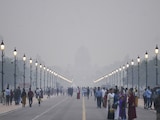The Ministry of Home Affairs has finalised deployment changes for the Amarnath yatra this year for better security management. For the first time, the Indo-Tibetan Border Police (ITBP) has been tasked to guard the cave shrine this year along with the Central Reserve Police Force (CRPF) which would be deployed just below the stairs of the holy cave.
The decision was taken based on suggestions from the Jammu And Kashmir Police and Shree Amarnath Shrine Board (SASB) in a meeting today.
Union Home Secretary Ajay Bhalla chaired the meeting on preparedness for the Amarnath yatra which is scheduled to start from July 1. In it, the role of all forces was decided "location-wise". All heads of the Central Armed Police Forces participated in it, including Director Intelligence Bureau Tapan Deka and secretary, Research and Analysis Wing Samant Goel.
"Jammu Kashmir Police had laid out their issues and requirements and after assessing them fresh deployments were assigned to various CAPFs," a senior official disclosed.
He said the ITBP played a crucial role last year after flash floods.
"More so they are a mountain force which is trained for natural calamities," a senior officer explained.
In 2022, cloud burst had triggered flash floods in which many lives were lost at the foothill of the cave. ITBP jawans were the first responders - as one company was deployed there - and managed to save many lives.
To avoid casualties from flash floods and glacial lake outburst floods (GLOF), the NDRF has been deployed and they helped authorities to identify locations for the creation of pilgrim camps.
At least 16 people were killed after flash floods triggered by heavy rain near the shrine on July 8 last year. To prevent such mishaps this year, helicopters of the Indian Air Force (IAF) and the Jammu and Kashmir administration have been asked to regularly undertake aerial sorties in the upper reaches of the holy cave to check for GLOF events and the formation of lakes that may trigger flash floods downhill.
Last year, such sorties were conducted only after the flash floods occurred in July. But this year, the exercise is being undertaken before the yatra starts and would continue in periodical intervals during the two-month pilgrimage.
"The aerial surveys will be conducted by a team with expertise in remote sensing and satellite, hydrology and disaster response. Once a dangerous water build-up is spotted, contingency measures will be taken all along the yatra route, especially the area near the cave shrine," explains an official aware of arrangements being made.
In the meeting, it was also decided that the ITBP and BSF troops will be deployed at six other locations along the route, a task usually rendered by the CRPF.
The CRPF has been traditionally guarding the cave shrine, located at a height of 3,888 metres in the south Kashmir Himalayas, for decades now and some vital pilgrim camps en route.
This year, however, changes were also made keeping in mind the "emerging security threats and challenges. "More so beause many companies of the CRPF are also in Manipur tackling law and order situation and in West Bengal for panchayat elections so the various other forces have been tasked along with them," added an official.















